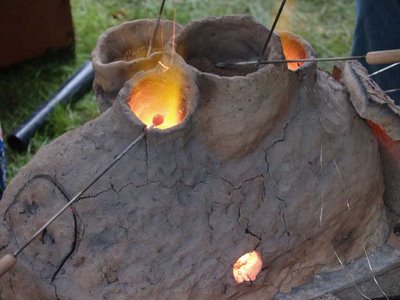Working System - Bead Furnace
Peterson Mk 5 Bead Furnace - July 18. 2009
 Showing the overall layout of working ports on the furnace
Showing the overall layout of working ports on the furnaceThe Mk 5 furnace is again laid out with working areas for two people, one on either end of a roughly oval furnace, which has air input and charcoal loading on either sides of the centre. At the top centre is a built in cup for annealing, for this test holding sieved wood ash. The loading port (not seen here) has a second cup which inserts into the opening. In this test this second cup held vermiculite.
Each worker has the choice of using an upper port, allowing for manipulation of the glass in the hot exhaust gasses. A second covered port in the side of the wall can be opened, allowing for working down inside the body of the furnace. This method was used for experiments with tesseri. (see the video segment posted earlier)
A thermocouple type pyrometer was employed to roughly measure exhaust gas temperatures at one of the top ports over the experiment. A roughly 6 mm (1/4 inch) diameter hole was drilled into the wall of the furnace, just down from the lip of of the port. The probe was extended into the opening about 1 cm. Although the probe was placed early in the experiment, and readings were constantly monitored, unfortunately the recorded data only extended over a relatively short time sequence:
Each worker has the choice of using an upper port, allowing for manipulation of the glass in the hot exhaust gasses. A second covered port in the side of the wall can be opened, allowing for working down inside the body of the furnace. This method was used for experiments with tesseri. (see the video segment posted earlier)
A thermocouple type pyrometer was employed to roughly measure exhaust gas temperatures at one of the top ports over the experiment. A roughly 6 mm (1/4 inch) diameter hole was drilled into the wall of the furnace, just down from the lip of of the port. The probe was extended into the opening about 1 cm. Although the probe was placed early in the experiment, and readings were constantly monitored, unfortunately the recorded data only extended over a relatively short time sequence:
Temperature Data (C)
| TIME | TEMP | EVENT |
| | | |
| 1:03 | 900 | |
| 1:04 | 1000 | |
| 1:07 | 900 | |
| 1:09 | 700 | |
| 1:10 | 800 | |
| 1:11 | charcoal fill | |
| | change method | |
| 1:15 | 755 | |
| 1:16 | 655 | |
| | adjust charcoal | |
| 1:17 | 925 | |
| 1:18 | 810 | |
| 1:19 | 850 | |
| 1:20 | 890 | |
| | | adjust charcoal |
| 1:21 | 910 | |
| 1:22 | 830 | |
| 1:23 | 860 | |
| 1:24 | 870 | |
| 1:25 | 840 | |
| 1:26 | 850 | |
| 1:27 | 820 | |
Darrell Markewitz
Labels: glass beads










0 Comments:
Post a Comment
<< Home